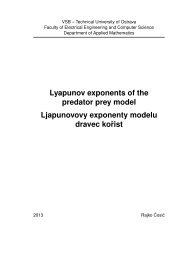The Boundary Element Method for the Helmholtz Equation ... - FEI VÅ B
The Boundary Element Method for the Helmholtz Equation ... - FEI VÅ B
The Boundary Element Method for the Helmholtz Equation ... - FEI VÅ B
Create successful ePaper yourself
Turn your PDF publications into a flip-book with our unique Google optimized e-Paper software.
80 5 Numerical ExperimentsE N Err D Err D,p Err N Err N,p Err ϑ320 162 3.09 · 10 −2 1.82 · 10 −2 1.78 · 10 −1 1.24 · 10 −1 7.94 · 10 −31240 622 7.96 · 10 −3 4.98 · 10 −3 9.60 · 10 −2 6.49 · 10 −2 1.68 · 10 −37432 3718 1.21 · 10 −3 7.46 · 10 −4 3.32 · 10 −2 2.62 · 10 −2 2.79 · 10 −4Table 5.7: Interior mixed BVP on <strong>the</strong> sphere.E N Err D Err D,p Err N Err N,p Err ϑ300 152 5.28 · 10 −2 4.54 · 10 −2 2.84 · 10 −1 1.88 · 10 −1 1.22 · 10 −21200 602 1.19 · 10 −2 1.03 · 10 −2 1.18 · 10 −1 9.47 · 10 −2 2.98 · 10 −37500 3752 1.80 · 10 −3 1.56 · 10 −3 4.15 · 10 −2 3.79 · 10 −2 5.37 · 10 −4Table 5.8: Interior mixed BVP on <strong>the</strong> cube.<strong>The</strong> results are summarized in Tables 5.7, 5.8 with errors given byErr D := ∥g D − g D,h ∥ L 2 (Γ N )∥g D ∥ L 2 (Γ N )Err N := ∥g N − g N,h ∥ L 2 (Γ D )∥g N ∥ L 2 (Γ D ), Err D,p := ∥g D − g D,p ∥ L 2 (Γ N ),∥g D ∥ L 2 (Γ N)and <strong>the</strong> curve ϑ: [0, 1] → R 3 defined by (5.4)., Err N,p := ∥g N − g N,p ∥ L 2 (Γ D ), Err ϑ := ∥u − u h∥ L 2 (ϑ)∥g N ∥ L 2 (Γ D)∥u∥ L 2 (ϑ)(5.6)5.4 Exterior Dirichlet <strong>Boundary</strong> Value ProblemNow we consider <strong>the</strong> exterior Dirichlet boundary value problem (3.43) with κ = 2. For <strong>the</strong>testing solutions we chooseu(x) := v κ (x, y 1 ) (5.7)with y 1 := [0, 0, 0.9] T in <strong>the</strong> case of <strong>the</strong> sphere and <strong>the</strong> cube andu(x) := v κ (x, y 2 ) + v κ (x, y 3 ) (5.8)with y 2 := [0.9, 0.25, 0.7] T and y 3 := [0.9, −0.25, 0.7] T in <strong>the</strong> case of <strong>the</strong> elephant.For <strong>the</strong> computation of <strong>the</strong> missing Neumann data we use <strong>the</strong> discretized Galerkinequations⟨V κ g N,h , ψ k ⟩ ∂Ω = − 1 2 I + K κ g D,h , ψ k <strong>for</strong> all k ∈ {1, . . . , E}∂Ωleading to <strong>the</strong> system of linear equationsV κ,h g N =− 1 2 M h + K κ,h g D .









